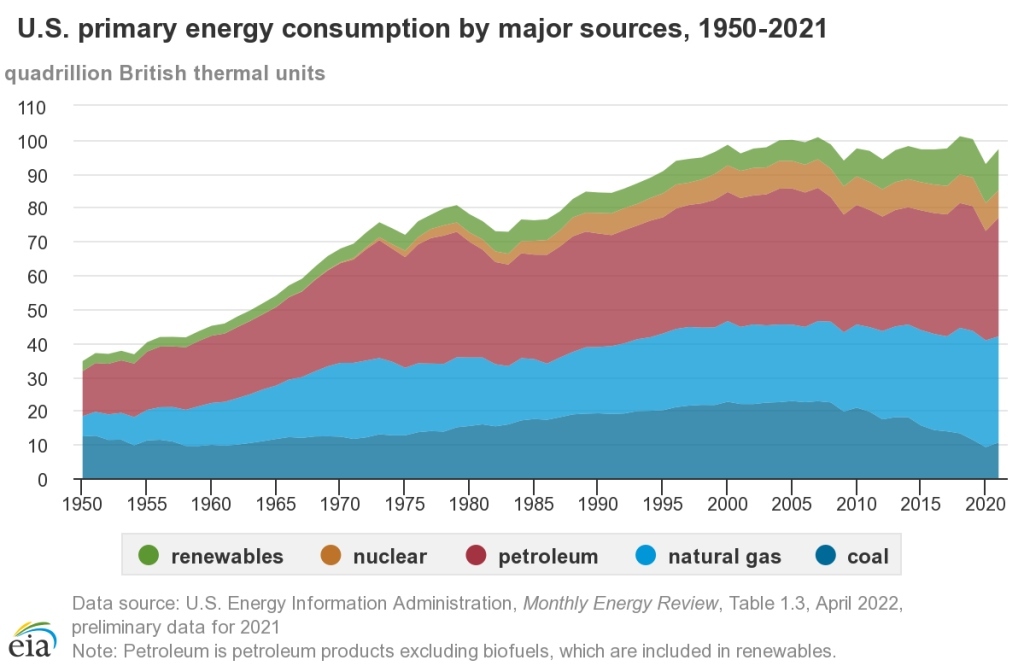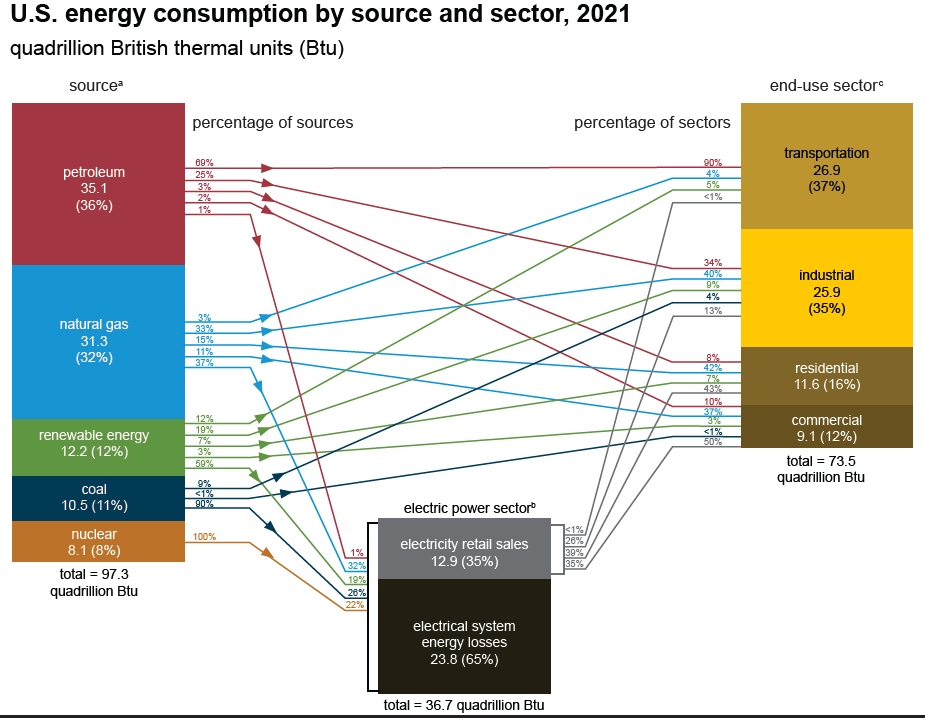Comments
- No comments found

Amidst all the discussions of how to encourage non-carbon sources of energy, it can be useful to step back and look at the basic patterns of US energy consumption. Here, I draw upon the U.S. Energy Information Administration webpage on “U.S. Energy Facts Explained.”
This figure shows US “primary” energy consumption by source. The attentive reader will notice that “electricity” does not appear as a source of energy. The reason, of course, is that while electricity is used primarily as a mechanism for transmitting power, and sometimes (batteries) for storing power, electricity is not a “source” of power itself, but instead needs to be generated from an underlying source.

As the figure shows, total US energy consumption levelled off in late 1990s. Use of coal is dramatically down in the last two decades, but use of natural gas has risen correspondingly–so that the sum of coal and natural gas in the figure hasn’t changed much in the last two decades. Petroleum as a source of energy is down about 10% in the last two decades. Nuclear has edged up just a bit in terms of total energy produced since 2000. The quantity of energy produced by renewables has doubled, from about 6 to 12 quadrillion BTUs.
The category of renewables, however, includes more than wind and solar. Here’s a breakdown for US energy consumption in 2021:

As the figure shows, two-fifths of renewables are biofuels, including ethanol and wood. About one-fifth are hydroelectric dams. The other two-fifths are what a lot of people mean when they refer to renewables: wind, solar, and geothermal. In other words, wind, solar, and geothermal are a little less than 5% of US energy consumption at present.
For those who are mentally relying on solar/wind/geothermal as the primary power sources of the future, these numbers suggest the scale of the challenge. The share of US energy consumption coming from fossil fuels–coal, natural gas, petroleum–was about 85% of the total in 2000, and is now about 79%. The rise in renewables, especially biomass, wind, and solar, explains how this decline in fossil fuels occurred.
But this change has taken two decades. If the US economy is going to consume roughly the same level of energy over time, which is the pattern of the last few decades, then wind/solar/geothermal will need to grow by a multiple of 10 if these sources are to provide half of US energy consumption. A transformation of this scale would require, among other changes, an extraordinary build-out of new power lines from these new sources of energy to where the electricity is needed; an extraordinary rise in mining to provide the materials needed both for solar cells and for the power lines; re-engineering the power grid to be more capable of addressing sources of electricity that can fluctuate; the development of new methods for storage of electricity for when the wind isn’t blowing or the sun isn’t shining; and an extraordinary rise in capabilities to recycle old solar cells and wind turbines when they have reached the end of their cost-effective lifespans.
My own sense is that new technologies will be needed in all of these areas, and others, including use of hydrogen for energy storage, nuclear as an energy source, probably methods of carbon capture and storage, and methods of conserving existing energy use.
Here’s a final figure to show some of the complexity of the energy problem. The left-hand panel shows the primary sources of energy. The right-hand panel shows the end-use sectors for energy. Sometimes the source of energy is used directly by a certain sector: for example, the top line shows that 69% of petroleum is used in the transportations sector, where it represents 90% of all the energy used.
In other cases, the primary energy flows through the electricity sector. For example, 37% of natural gas energy goes to electricity, as does 59% of renewable energy, 90% of coal energy, and 100% of nuclear energy. But of the energy flowing into the electricity system, about two-thirds is lost in maintaining the system itself, and only one-third goes back out to end-use sectors. To put it another way, when we build renewable energy sources to feed the electrical grid, only one-third of the electricity produced finds its way to end-users.

The challenge of reducing reliance on fossil fuels isn’t just on the left-hand side of this figure: that is, raising output of renewables in a way that can offset use of fossil fuels. It’s about rethinking and rewiring all the connections between primary energy and end-users in this figure.
Timothy Taylor is an American economist. He is managing editor of the Journal of Economic Perspectives, a quarterly academic journal produced at Macalester College and published by the American Economic Association. Taylor received his Bachelor of Arts degree from Haverford College and a master's degree in economics from Stanford University. At Stanford, he was winner of the award for excellent teaching in a large class (more than 30 students) given by the Associated Students of Stanford University. At Minnesota, he was named a Distinguished Lecturer by the Department of Economics and voted Teacher of the Year by the master's degree students at the Hubert H. Humphrey Institute of Public Affairs. Taylor has been a guest speaker for groups of teachers of high school economics, visiting diplomats from eastern Europe, talk-radio shows, and community groups. From 1989 to 1997, Professor Taylor wrote an economics opinion column for the San Jose Mercury-News. He has published multiple lectures on economics through The Teaching Company. With Rudolph Penner and Isabel Sawhill, he is co-author of Updating America's Social Contract (2000), whose first chapter provided an early radical centrist perspective, "An Agenda for the Radical Middle". Taylor is also the author of The Instant Economist: Everything You Need to Know About How the Economy Works, published by the Penguin Group in 2012. The fourth edition of Taylor's Principles of Economics textbook was published by Textbook Media in 2017.
Leave your comments
Post comment as a guest